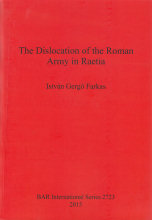
FARKAS : The dislocation of the Roman Army in Raetia (bevezetés)
In the last century, researchers have uncovered approximately fifty Roman forts via excavations in Raetia. The rapid technological advancement of the last two decades allowed to use a variety of non-destructive methods with increasing precision and range. These methods (including regular aerial surveys, geophysical prospection and LIDAR scanning) enabled the discovery and identification of more than thirty, previously unknown forts and Roman military installations. Furthermore, these new methods allowed to observe more precisely the mostly unknown inner layout, ground-plan and periodization of the already-known forts' buildings. Dendrochronological analyses supplied data to the dating of some of the fort's defences and structures, which, in numerous cases, led to a drastic redefinition of previous chronology, which was mainly dependant on the typology of finds.
The construction reconstruction phases of several forts was modified by decades, thus resulting in the establishment of a completely new chronological system regarding the history of Raetia O. Braasch. W. Czysz, J. E. Faßbinder and C. S. Sommer are the main advocates of these new methods. The spread of non-destructive archaeological methods did not effect a deaease in traditional excavations and fieldwork. Thus the number of known epigraphic sources from Raetia increases even nowadays. The discovery of new inscriptions displaying the names of units as well as Raetian discharge documents continue to further enrich and tinge our knowledge on provincial military history. The dislocation of Roman auxiliary troops in Raetia was first summarized by H.-J. Kellner in a short article of eight pages in 1971. The system he established continued to be in use, despite the various changes in the operating of the forts brought about by the above-mentioned new methods. Publishers of Raetian military diplomas discovered during the last two decades, continued to use H.-J. Kellner's system with minor improvements, but the overall re-examination and reestablishment of H.-J Kellner's system was yet to be done.
Due to this significant bias between the system of forts and the system of units – the two of which should not and cannot be separated – it has become inevitable to draw up a new dislocation regarding Raetia that considers the results of both research branches, i.e. that of the forts and that of the units. The summary of forts and units on a provincial level allows to further specify historical details and furthermore, enables a better understanding of the events that occurred and the relations that existed between Raetia and other Roman provinces.
This book aims to fulfil three goals:
1. Collecting, organizing and examining different sources of Roman military history in regard of Raetia (archaeological evidence, literary, epigraphic and numismatic
evidence) together, in order to reach new conclusions with an interdisciplinary approach of these materials.
2. Establishing the dislocation system of the Roman army in Raetia during the Principate.
3. Providing an up-to-date synthesis on the social, economic and religious aspects of the Roman army in provincial life.